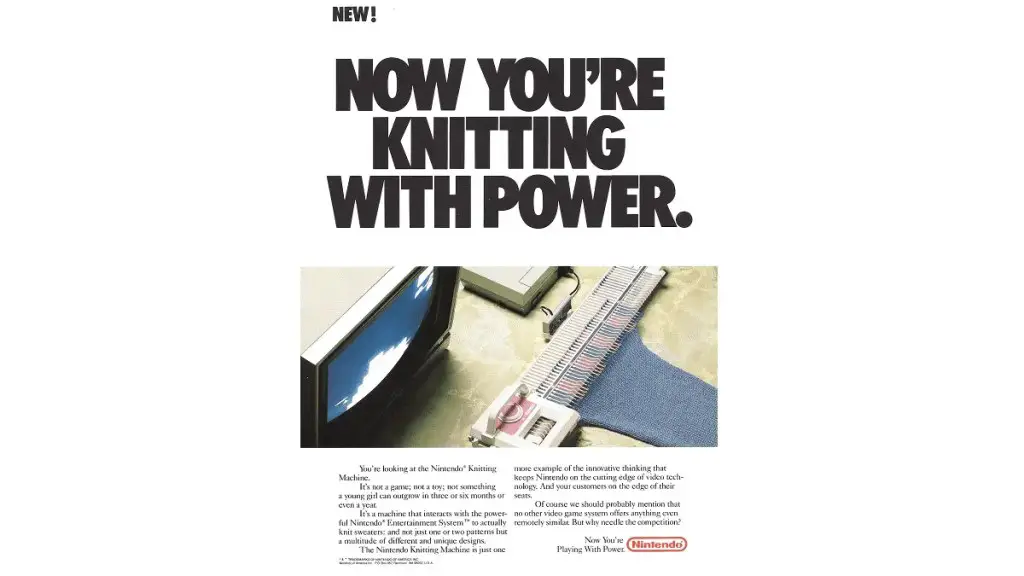Nintendo’s Entry Into Knitting
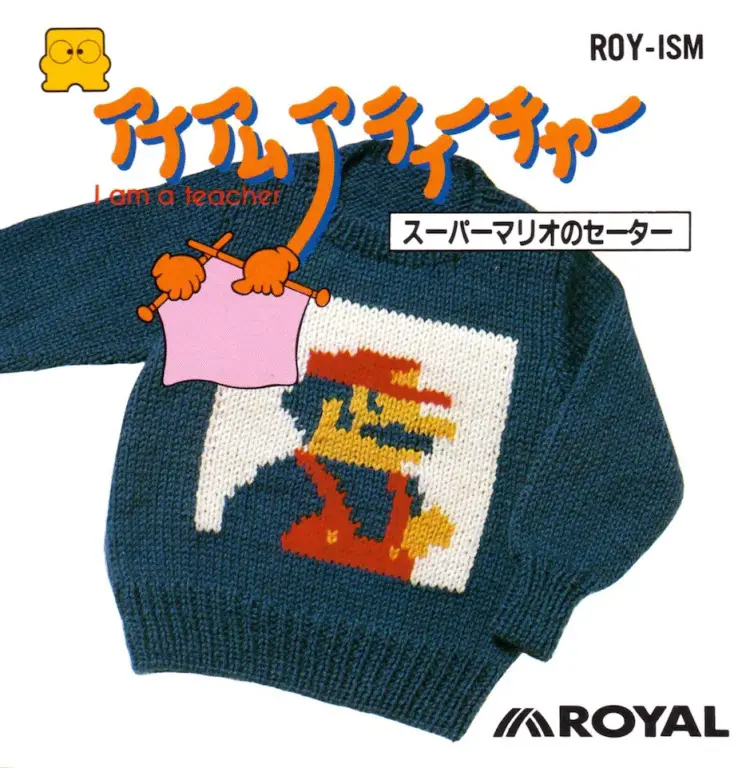
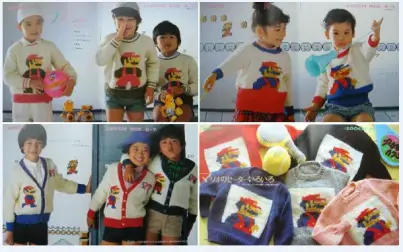
Strangely enough, Nintendo’s foray into knitting wasn’t a one-off situation. In 1986, the company released a game called I am a Teacher: Super Mario Sweater for the Famicom (short for family computer), the Japanese equivalent of the Nintendo Entertainment System (NES). Players would input their measurement sizes and begin designing sweaters by adding 8-bit style graphics of characters from the Super Mario Bros. games. Once the design was set, the player could send it to Royal to get a sweater manufactured with their design for 2,900¥.
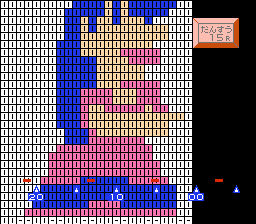
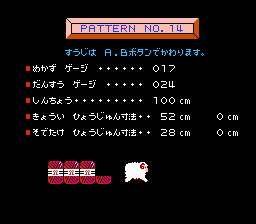
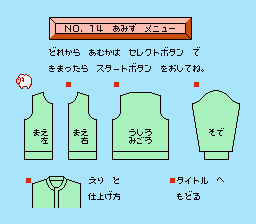
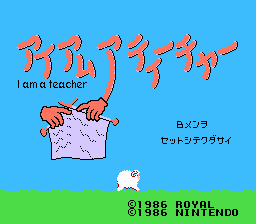
Now You’re Knitting With Power
Nintendo’s love affair with knitting continued a year after the release of I am a Teacher: Super Mario Sweater. In 1987 at the Consumer Electronics Show (CES), Nintendo unveiled what is perhaps still their strangest video game accessory to date—the Nintendo Knitting Machine System. This contraption hooked up to the NES and would churn out knitted designs in conjunction with a custom game cartridge. Imagine being able to make your own ugly sweaters in the comfort of your own home! Well, if that doesn’t sound fun, I guess you’re not alone because the Knitting Machine System never made it to market.
To understand the accessory, you need to know a bit of video game history. When the NES launched in 1985, the U.S was still facing the aftermath of the video game crash of ’83. Hence Nintendo’s statement at CES that they were experiencing a “Phoenix-like rise from the ashes”. Part of the company’s strategy that precipitated that rise was to make their video game console, seem not like a video game console.
According to an interview done with Lance Barr, the designer of the NES, that’s why the NES was redesigned to look like a VCR. It further distanced itself from consoles of its day by launching with another famous accessory, the Robotic Operating Buddy (R.O.B.). Through that lens, the Knitting Machine System seems to fall perfectly in line with Nintendo’s strategy at the time. In the words of Nintendo’s Advertising Manager at the time, Gail Tilden, “we’re using entertainment technology to appeal to a broader base”. However, doesn’t mean that it wasn’t still quite the spectacle.
KNIT ONE, NINTENDO: Atari’s booth may have been the most bustling in the Convention Center’s West Hall, but Japanese video game maker Nintendo was drawing a crowd at an offbeat knitting demonstration.
Knitting by computer? Yes, knitters can throw away those needles. By draping yarn across a loom-like affair that interacts with the company’s home entertainment system, the user can knit sweaters, mittens, socks–you name it–complete with patterns. And no more counting rows. The computer does it all.
– LA TIMES JAN. 12, 1987
How The Knitting Machine System Worked
According to the 1986 patent filed by Nintendo, the Knitting Machine System was designed to be used with the Famicom. However, they did not intend to keep it reserved only for Nintendo game consoles. Instead, the patent noted that the Knitting Machine System was “not limited to [the Famicom] and can be applied to various other personal computers and the like”.
The system was developed by Masakazu Nagano and Yasuko Nagano who developed other patents for Nintendo. The Knitting Machine System worked in conjunction with a “memory cartridge… detachably connected via an edge connector”. This refers to a custom Game Pak (Nintendo’s branding for the NES and Famicom game cartridges). The Game Pak included the program’s memory for storage of program data and non-volatile memory (for example, a ROM, an E-PROM, or a battery) that stores character data. This was important as without a battery, Game Paks or the NES itself had no way of saving information.
With the ability to save, users weren’t required to “perform the entire knitting process all at once without any interruption from the beginning to the end”. Nintendo foresaw that “some users may want to interrupt the operation halfway. In that case, when it is determined that the final stage is not knitted… the stage number data at that time may be stored in the memory cartridge” so the project could be picked back up at a later time.
Pattern Visualization
The image of the pattern to be knitted would be generated based on the character data stored on the Game Pak. It would be displayed on the screen as it was being produced by the user on the Knitting Machine System. Additionally, the Knitting Machine System had its own LCD screen capable of displaying “various data”.
Retro USB made their own Nintendo Knitting Machine System from a Brother KH910 knitting machine and an “Arduino + shield (without the NES connection) that replaces the original electronics”. You can see it in action in the videos posted below.
The Knitting Machine System Makes its Rounds
According to Howard Phillips, who in the 80’s and 90’s was the company’s most prominent spokesman, “Mr. A (Arakawa) asked me with just 30 minutes notice to give Toys R Us Chairman Charles Lazarus a live demo. Likely one of my least genuinely enthusiastic demos. Phillips also quoted American columnist and broadcaster John Dvorak as having said the following about the Knitting Machine System.
An interesting application at the CES show was a design tool for computer-aided knitting, of all things. You can for example design a fancy sweater with the computer. A special program turns the data into knitting instructions for a special Nintendo knitting machine that is expected to sell for less than $100.
One fellow at the Nintendo Booth says the machine can crank out a custom sweater in about four hours. While that may be an exaggerated, this device is a runaway hit in Japan, and Nintendo hopes it will take off here. I’m convinced this knitting software will help reintroduce the home computer to the public.
John Dvorak Jan. 11, 1987 – via Howard Phillips
Nintendo Knitting Machine System Patent Documents
More Stores You’ll Love!
If Nintendo oddities interest you, check out the story of how the company managed to cram LCD games on wristwatches in the 90’s or how they turned the SNES into a military training machine for marksmanship.
Nintendo Designer Lance Barr’s Work on NES Modem, SNES Console
